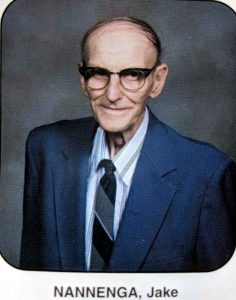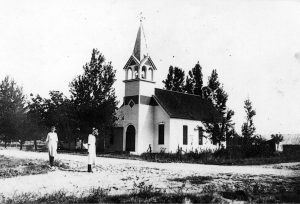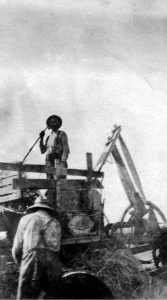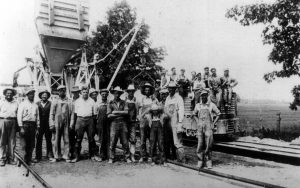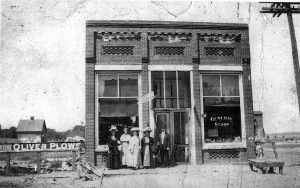Jake Nannenga
THE SETTLING OF THE GRAND MARSH OF THE KANKAKEE RIVER
Interviewed by Laverne Terpstra, Transcribed by Shirley Zeck
September 1992
I was born in Newton County. I think we moved away from there the next year and we moved over here on the Otis Ranch. I was born April 21, 1904. My parents came from Holland. Dad came from Groningen and my mother from Friesland and they settled up here.
My mother was fifteen years old and she worked for Halleck who used to be in town. She had an awful time understanding the language at first. She took care of their boy, he was eight or nine and she was fifteen. I don’t know what relation they were to Abe Halleck, but maybe cousins. And when my mother died, that boy she had taken care of came over to see her after she had died. He bought up hay and all stuff like that and he shipped it out. There used to be a lot of hay fields around. Where Pete Walstra is living (6220 W SR 10), that whole section was all hay. And I know whoever farmed it cut the hay. Broetjes cut the hay, baled it and took it to the box car and then shipped it to Chicago. That was his business. Really what all he done, I don’t know how long he stayed there. He was the buyer and he sold it up there at the yards (stockyards).
Most of the time, until I was fourteen, we lived over here on this Otis Ranch. After that we moved across from the Dutch Church. I lived there till I got married, with the folks. I had five brothers and two sisters when I lived across from the church. Sue, who married Al Kingma, was my twin sister. Minnie is still living. Minnie is going to be ninety-two years old the seventh of this month. I was just writing a birthday card. I am eighty-eight.
We didn’t realize we had hardships so much, but I knew we worked awfully cheap. A dollar a day was big wages at the time. And I remember when I was pretty young we cut wood for Jimmy Rose for a dollar a day. And when I was fifteen I started working for Dan Sipkema. I started there the first of march and on April 21 I was sixteen. He was a nice guy to work for, too. You mom would remember that, she worked there too. She helped Grace in the house. There was a lot of milking and practically all farm work.
I remember that fire they had there (DeMotte). That was in 1936 when the whole town nearly burned. There were two stores, I think, Case DeKock, Uncle Case, and Hank Swart had one on the corner. And of course Herman Osting had the shoe store. These were when I was a kid. I think John Terborg had a coffee store there and Cheevers, of course, had their garage. I don’t remember, but I heard about a John VanBeek store. I think that was over by the corner where Ed DeBruin used to be.
There used to be a pickle factory in DeMotte. We used to have a lot of pickles. We’d pick pickles down there and we’d have to have them all sorted. There were the cukes and the dill and then the little pickles. They call them sweet pickles, I think. We took them down there. We’d have to have them all sorted.
An old guy came along there. He had a car that ran on diesel fuel, I think. That was something awful strange at that time. He was supposed to be a big shot. Check them all over and see if it was done right up there at the factory. I don’t remember who owned it. They had around a dozen of them big vats. They were big around. Wee called them silos. They held a lot of pickles. People raised a lot of pickles around here in them days.
We used to bring our milk to the cheese factory. I don’t remember the guy’s name, but they always called him “Cheesey”. Farmers would bring their milk, have it separated and they would make cheese out of the cream. What was left was called whey. I don’t think it (the cheese factory) lasted too awful long. It was on the east side of the road near the NAPA store. I was still home when they had the cheese factory (800 15th St. SE). Doc Oosten was the veterinarian there, too.
I helped clear land where Ronnie Mosier lives now (12611 N 1000 W). We called it underbrush. Andrew Woudema was our foreman. He treated me awful good. There were around eight men working there at the time. We had mostly just axes. There weren’t many stumps left. The brush was small enough so there wouldn’t be much of a stump. We would clear about one and a half acres a day (eight of us). It didn’t take too awful long. They made pasture out of it after they got it cleared. It was by the Dutch corner (9991 W 1200 N), we had our cows down there and we pastured it. That was before Nick DeVries bought it. Nick lived just one-fourth mile north of the Dutch Corner. He had cows and the pasture was on the road. We would bring our cows. His cows would come and join our cows, we would bring them there together. They ate wild grass. At that time there wasn’t very much farm ground. It was all pasture. Not many crops were raised on that ground yet. Later we would farm a little of it right along the track. It was poor ground. It has been built up and is pretty good ground now. In the summer we had silage to feed the cows. We raised corn on our farm that was right across from the Dutch Corner. We had 160 acres that my dad owned. We raised corn and a lot of our garden stuff there (a lot of truck garden). We peddled most of our truck garden products. Later they had a market in Gary and my brother Robert would take that to the market. There were a lot of farmers in DeMotte that went to the Gary Market.
We had practically all the farm tools, also a cabbage planter, something like a potato planter. We raised a lot of potatoes and cabbage. Outside of that it was just a general farm. We had a potato digger.
I worked a lot with threshing gangs when I was home and when I was working for Dan. We threshed all the neighbors. I think there was Jake Hoffman, Andrew Sipkema, Dick Peterson and Dan in that threshing ring. They all worked together. The hired men were sent out to do the threshing and for some reason, I don’t know just why, they weren’t working together like they should, so one of the farmers had to come out and boss the job.
I always like to go threshing. They fixed a real good dinner. When Dan told me I had to stay home, Grace and I would have to do the milking at night. I knew we had between forty-five and fifty cows and we milked them all by hand, just the two of us. That was quite a chore. We would start out around four o’clock and be done around six. In the summertime we would turn the cattle out at night. We’d get up at four o’clock in the morning, get the cows, put them back in and milk them.
All the Otis Estates had cattle. Everyone of them had cattle outside of Bert Hanaway. The rest of them, they had dairy cows. I worked for Andrew Sipkema for awhile and he raised hogs. Most people just raised hogs for themselves. I don’t remember Dan having any hogs, mostly cattle to speculate on. They do that yet over there at Dan Sipkema’s. Also Babe Evers has cattle.
Usually chickens belong to the farmer. A lot of the farmers had chickens to get their groceries. They sold eggs. Most of the milk was shipped to Hammond, first by train. In the spring everybody would be fighting for milk cans. Everybody was always short.
We shipped around twelve or fifteen cans of milk. We’d load them in a wagon and take them to Pembrook over by Fair Oaks. It was just a train stop to pick up the milk, nothing there but one farmhouse. We’d have to get down there before nine o’clock, it was pretty early. We had to hurry to get our milking done. The farmers and train people helped load the milk. It was whole milk.
I worked on the road from the river to the Potter Farm (14650 N SR 231). We put gravel in there, it was before they put the cement on. It was in the winter and Fred Coberly from DeMotte and I worked together. He had a team of horses and I had a team of mules. I kept my miles by John Bunning, and I had to go there to feed them. So some mornings when I’d go to work it was pretty rough. A lot of times Fred Coberly and I would be the only two working. John Akers had a railroad switch there by the Mak place (14100 N US Hwy 231), and they would have gravel there. We’d have to scoop that on the wagon and haul it down there. We scooped it all by hand. We always walked beside the wagon because it was too cold to ride on the wagon.
I always let the other guy go first, Fred Coberly. I’d always follow him. He had a twitch on his shoulder and it kind of fascinated me just to watch him. A nice guy though. We worked there all winter. A lot of times we were the only two there. When the weather was decent we had quite a few of them to work, hauling gravel.
It was a long time later before they made the cement. I suppose we could haul about a ton of gravel in our own wagons. It was a dirt road when we put the gravel on. We didn’t have to scoop the gravel off. We had like 2×4’s and 4×4’s and the ends they would have them so you could catch a hold of them and pull the whole bottom right out. The gravel would fall out. It was made that way. It had sides but the floor was just 4×4’s. Somebody else would level the gravel after it was out.
I worked on that road where Bill DeYoung used to live (1400 N). I had that same team of mules. We scraped that before they put gravel on it. They’d dig the ditches and we’d scrape that. I worked there and Tom Swart was there. He had a team of horses. There were three or four of us there. Murray Spurgeon always filled my scraper and somebody else would dump it. It worked out pretty good.
I hauled gravel on that road where Andrew DeHaan used to live (1300 or Division Rd). I remember that so plain. I still had that same team of mules, of course. There is a hill just before we got to Andrew DeHaan’s place, a pretty big hill there, and them mules, when they’d get tired, they’d stop. It wouldn’t make any difference whether you would want them to go or not. But after they had rested they would pull right off again, they’d start right up. A guy came along with empty wagons and had to pull off the road to get around me. He told me I didn’t know nothing about how to drive a team of mules, so it was kind of fascinating I guess. He grabbed the lines. Of course the mules had rested awhile so they were ready to go. He starts hollering at them and the mules took off a sailing. I said, “You don’t know how to drive a team of mules.” If I would have hollered at them like that it wouldn’t do them any good. When they got tired they just stopped. They took care of themselves. I never helped put on the concrete. That was quite an operation. Most of the bridges were plank bridges with no sides.
I started school over here where Harm Pruis used to live (9100 W 1100 N). There was a school house there. We started going there. I don’t remember the name of the school. I couldn’t keep them schools straight. I went to the town school for one year, I think. I think I was in the fourth grade. I went to school in sort of a station wagon, pretty nearly. It was closed in, you know, but a team of horses pulled it. About eight or ten would fit in there. I think the driver sat inside too. It was fixed so the lines would go right through.
Most of the houses on the Otis Ranch were pretty much there already. When I was first married I lived near Gabe Musch’s place (Rolling Meadows subdivision on 1200 N). It was a little ways off the road. Rich Evers lived right there where Kosters live now. And we lived a little ways across the lane there. There was a lane going to our house. We lived there the first year. Then we moved across from Rumpke Sipkema’s house. There was an old house there, one half mile west of the Dutch Corner Church, up on a hill. We had a few cows, just enough to have cream to take to town to sell. And we had a few eggs. That’s about the way we got our groceries. We had some corn to feed our cattle. We didn’t have much to sell. The first car I bought was an Oldsmobile. I had quite a few cars. I always bought old ones and they didn’t last too long.
When I was a kid we played baseball quite often across the road from our house. We’d go to town in the wintertime and watch them practice basketball. If we were lucky, when one of the guys didn’t happen to be there, they’d let one of us play.
We played a lot of checkers when I was home and after I got married, Ralph DeKock and I played a lot of checkers together. At one time we had a regular championship up there in town, Joe Ruisard, John Bunning, Maurice Bunning, Ralph DeKock and Sam Kingma. There was quite a bunch of us there.
Joe Ruisard was there, and of course, I was there. We were playing checkers at Case DeKock’s store (814 S. Halleck). We’d always have a checkerboard there. When it wasn’t too busy, Ralph would come back and play checkers with us too.
The championship games were played in the schoolhouse. If I remember right, Joe Ruisard and I think it was Sam Kingma. I ain’t sure, they had quite a time. They were pretty evenly matched you know. They played quite a few games together. If you get the right checkers you can pert near have a tied game. It was just kind of town people.
The town would be open on Wednesday and Saturday nights. They had a pool table there that cost money and we didn’t have any at the time. Barden Tyler was a good player. They said it took a bushel basket full of nickels to play pool with Barden. We didn’t have that many nickels. The pool parlor was south of DeYoung’s John Deere store next to Marie Osting’s store (820 S. Halleck). Also, the post office was near there.
This concludes the interview with Jake Nannenga.
Transcript of Taped Interview with Jake Nannenga
Interviewed by
Laverne Terpstra
Transcribed by
Shirley Zeck
Sponsored by
DeMotte-Kankakee Valley Rotary Club
Oral History Project


